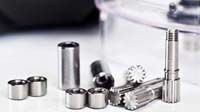Challenge: Lights Out Machining, Reshoring
Machining Solution: Tsugami SS20 and BS12 Swiss Type Lathes
Result: Better Product, Lower Cost, Faster Delivery Times
Location: Orem, UT
 Read how Blendtec improved the quality of their commercial blenders by re-shoring critical parts with the help of three Tsugami Swiss Type CNC Lathes integrated for unattended operation by Rem Sales.
Read how Blendtec improved the quality of their commercial blenders by re-shoring critical parts with the help of three Tsugami Swiss Type CNC Lathes integrated for unattended operation by Rem Sales.
In 1975, years before Tom Dickson became an internet and media celebrity in the amusing “Will It Blend?” YouTube video series, he was revolutionizing the home wheat milling industry, taking it from stone grinding to his patented stainless steel milling heads. Since then, Dickson has continued to improve the form and function of his products and product lines.
Along the way, he designed a blender with a distinctive square pitcher, rather than the conventional round shape. He ground up all sorts of unusual items during the research and development stages, pulverizing 2×2 boards with his blenders to test their ruggedness. Fortuitously, he launched his line of commercial blenders 17 years ago, just as fruit smoothies and coffee frappes were starting to become mainstream.
Today, Tom Dickson is still inventing new products and uses for his blenders. His Orem, Utah based company is thriving, and 270 people comprise “Team Blendtec.” Blendtec machines are mixing all sorts of concoctions in homes, restaurants, smoothie shops, coffee bars, and tea rooms.
Dickson’s ingenuity does not stop at the product research department. In 2008, he considered his metal parts manufacturing operation, and thought it could be significantly improved. At that time, most of the motor and jar parts were made by outside vendors–– some in China.
Tom had a desire for Blendtec Corporation to become more vertically integrated, and he knew that to bring additional manufacturing in-house, re-shoring it back to America, would require advanced CNC machine tools to be competitive in a global economy.
Further, to save the company even more money, he wanted the CNC machines to run for days without operator intervention–– lights out. Together with his manufacturing engineer, David Voorhees, they researched several machine tool providers and ultimately decided upon Tsugami/REM Sales to develop a turnkey solution.
“We were a challenging customer,” says David Beck, President of Blendtec. “Right off the bat, Tom and Dave wanted two CNC lathes to run at least six hours unattended, and we knew nothing about the Swiss Turning process. We relied on REM Sales to develop a manufacturing system and process: program the parts, test run the parts, set up redundant tooling, and perform tool monitoring. Plus, we challenged them to integrate the bar feeders, coolant, and chip systems, and so on–– the whole package.”
As with any sophisticated manufacturing technology and ambitious goals, there were hurdles to overcome and tweaks to tune, which REM Sales resolved. Once the process was robust, Blendtec added a third Tsugami BS12 Mark 5 Swiss Type CNC Lathe in 2009. Last fall, they purchased two Tsugami SS20 Swiss Type CNC Lathes. Those CNC lathes are running two parts simultaneously, essentially producing the output of four CNC machines.
Today, all of the Tsugami Swiss Type Lathes are operated by three people and run seven days a week, 24 hours a day. “We’ve been working like that since June 2008 when we got the first two CNC lathes on line,” says engineer Dave Voorhees.
Learning the life of each and every tool was one of the most time-consuming aspects of ramping up to unattended Swiss turning operation, according to Voorhees. REM Sales’ engineers wrote macros for each tool to accommodate for wear and to trigger offsets in the program to maintain part geometries and tolerances.
Blendtec uses an oil-based coolant composition and high pressure systems with all of its Tsugami CNC Lathes to keep the tool/workpiece interface clear of chips and extend tool life. However, the oily mist in the cutting area of the machines can be flammable. Fire suppression systems are integrated with all of the machines.
On the newer SS20 Swiss Type Lathes, monitoring systems are poised on the main spindle, subspindle and both live tool spindles to detect any anomalies. In the event there is a tool break or other problem, the monitoring software spurs a call to a machine operator who comes in and gets the CNC Lathe back up and running.
“We have noticed several areas of improvement now that we are manufacturing in-house with these particular machine tools,” says Beck. “We make about a dozen different parts in our factory, the details of which are proprietary. A product is the sum of its parts, and the quality of our blenders is enhanced because each individual part is better-made. The mixers assemble easier. They operate better. Heck, they even grind up iPads on one of Tom’s most recent videos. Our costs have lowered. Our delivery speeds have risen. In fact, delivery is almost immediate because 98 percent of the product is now made right here. Cycle times in general have reduced by at least two-thirds compared to what the outside vendor was achieving, and they will continue to go down. We’ve refined the process over the years and will continue to do so.”
Manufacturing engineer Voorhees elaborates on the significant reductions in cycle times, particularly as each Tsugami SS20 CNC Lathe is making two parts simultaneously. On one part, they went from a five minute cycle time four years ago down to 90 seconds now. He estimates the time will reduce to 75 seconds before long. On another part, the machining time used to be two minutes, now it is 30 seconds.
For other OEMs or shops looking to leap into lights out manufacturing using the Swiss turning approach, engineer Voorhees offers the following advice:
First, use precision ground bar stock. At Blendtec, it is common for part tolerances to be in the ten-thousandths of an inch range. Likewise, the material, in some cases hard stainless, must be very high quality, straight, packaged for protection, and delivered with care.
Second, knowing the tool life of each tool is very important. “You have to watch the tools, and it just takes time. There are no short cuts to gaining that knowledge,” says Voorhees, “but that data is the pathway to success when it comes to an optimal lights out operation.” He also adds that experimenting with different tool brands can save a lot of money.
Third, he recommends using a high pressure coolant system to keep the work area thermally stable and free of chips and swarf. The systems integrated with Blendtec’s Tsugami CNC lathes are from MP Systems, Inc. He also believes that using an oil-based coolant has helped extend tool life in Blendtec’s applications. He acknowledges that oil is more expensive to buy and to discard of properly, however he strongly believes the company saves costs in the long run, particularly with tools and reliable part quality.
Fourth, he cites the chucker mode option, available only on Tsugami CNC lathes, as extremely beneficial. Using the lathe in chucker versus guide bushing mode avoids the wasteful 9 to 11-inch remnant of material. He concedes that some parts can only be made using the guide bushing mode, but that it is advantageous to have the option to use it as a chucker whenever possible.
“Whenever I host a tour of our facility, I’ll pick up a couple of mating parts out of separate bins,” says Blendtec’s president David Beck. “They always fit beautifully together. That did not always happen when we were buying parts outside. It’s a testament to our quality. I can’t imagine anyone who could not compete with the Chinese or anybody in the world when you have an automated process like this.”
While Tom Dickson’s manufacturing team is whipping up productivity, he’s whooping it up on YouTube, and having a ball. Contact Tsugami/REM Sales and see how you might join the trend to re-shore your manufacturing operation and reap the benefits of lights out manufacturing.
